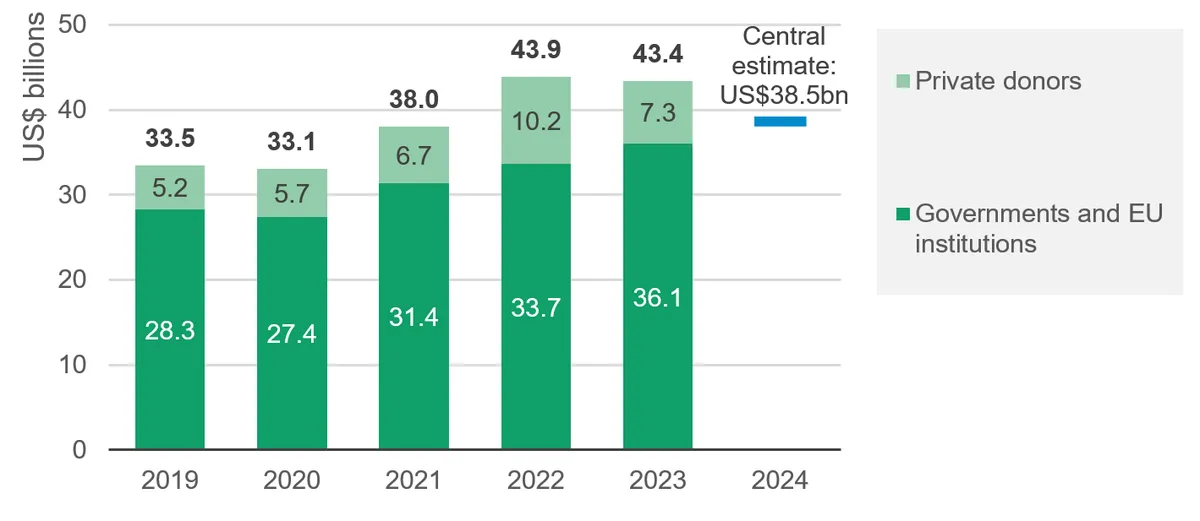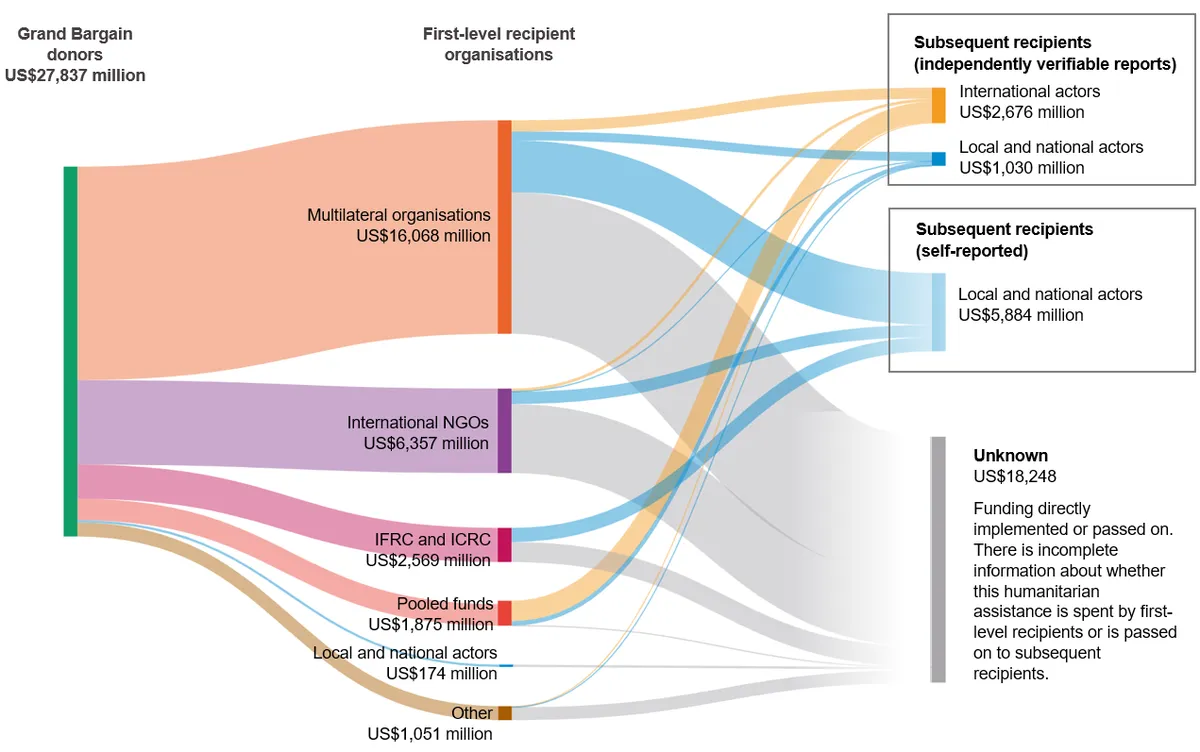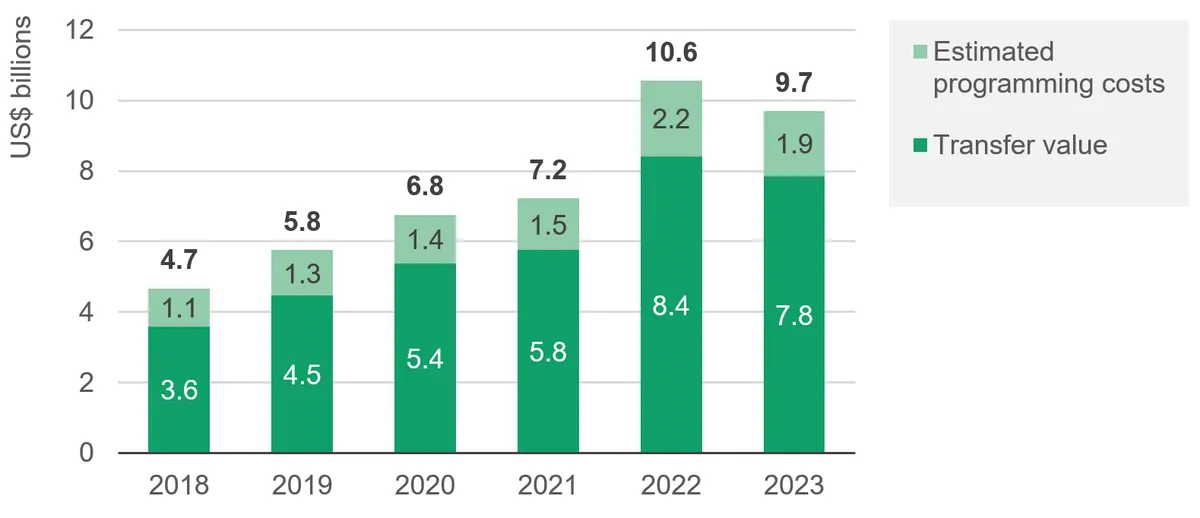Overview
Funding to the humanitarian sector stalled in 2023, failing to keep pace with rising demand. While international humanitarian assistance remained historically high at over US$43 billion, interagency appeals faced a funding gap of US$32 billion, the largest on record. Ultimately, humanitarian funding and reform efforts fell short, and many millions of people targeted by international humanitarian responses did not receive the support they needed. [1] With key donors and organisations across the sector making budget cuts, Development Initiatives’ (DI’s) projections indicate that funding will fall further in 2024.
In 2022, most of the largest humanitarian donors increased their contributions in response to the Ukraine crisis, but the picture in 2023 was mixed. Several made significant cuts, including the UK, Germany and Canada. While these were mostly offset by increases from other donors such as Japan and Norway, the donor base continued to narrow, with a small number of donors providing the vast majority of funding. Taken together with the overall funding decrease and reports that major donors are planning further cuts, this underlines the fragility of a system already under strain.
International humanitarian assistance continued to focus on protracted crises, part of a significant shift over the last decade. In 2014, only 29% of funding required for interagency appeals was for protracted crises, but in 2024 this had reached 91%. This should spur more coherent action across the humanitarian–development–peace nexus to address the underlying drivers of crises. It also reinforces the importance of Grand Bargain commitments to increase multi-year funding and planning.
► Read more in Chapter 1, which gives a global overview of crisis and funding response .
Funding to local and national actors
While more funding is essential to keep pace with need, it is equally important to improve how funding is channelled to crisis responses, to ensure the most effective use of limited resources. Some progress was made in 2023 across several key areas in this regard. Despite the longstanding Grand Bargain commitment to provide an aggregate of at least 25% of funding to local and national actors as directly as possible, Grand Bargain signatories only provided 4.4% of their total funding to local and national actors in 2023, and only provided 0.6% directly (based on independently verifiable data). Multilateral organisations continue to receive the largest share of international humanitarian assistance, while transparency on funding to subsequent recipients remains challenging. Across the broader humanitarian system, direct funding for local and national actors increased from 2.3% to 4.5% of all trackable funding, but this was due to new allocations by two specific non-Grand Bargain donors.
However, a lack of data and inconsistent reporting by intermediaries makes overall funding to local and national actors impossible to assess comprehensively and verify independently. In 2023 pooled funds channelled 18% of their funding to local and national actors, the highest proportion since 2018 and an increase in volume of 49% over this period. UN OCHA’s country based pooled funds – which provide highly transparent data on funding allocations and sub-grants – continued progress in increasing their share of funding to local and national actors to 30% in 2023, although overall volumes decreased.
Obtaining support for indirect costs and overheads remains a challenge for local and national actors. Guidance issued by the Inter-Agency Standing Committee in 2022 based on research by DI [2] has spurred some momentum on this issue, as increasing numbers of donors and international intermediaries have published policies and changed their practices. However, more than half of Grand Bargain signatories do not have publicly available policies, and those that are available vary in quality and implementation. USAID and NEAR stand out among Grand Bargain signatories, both covering up to 15% of indirect costs for local and national actors, while several private foundations led the way outside the Grand Bargain, covering up to 25%.
► Read more in Chapter 2, which assesses funding to local and national actors . The chapter concludes with a contribution from Elise Baudot Queguiner, Head of Humanitarian Financing at the International Council of Voluntary Agencies (ICVA), which emphasises the need to increase funding to local and national actors and make it more accessible, transparent and of higher quality.
Cash and voucher assistance
The adoption of humanitarian cash and voucher assistance (CVA) has grown significantly over the last decade, but 2023 data suggests that this growth could be stalling. Growth has been driven by donors and implementers alike, who largely agree it can be a more cost-efficient way to deliver assistance than other delivery modalities, and that cash provides choice and dignity to affected populations. The volume of humanitarian CVA declined for the first time in 2023 after years of growth in line with a decline in overall funding, but it grew slightly as a share of overall international humanitarian assistance.
For the Grand Bargain, growth in global volumes of cash and voucher transfers is one of the few success stories, increasing from US$3.6 billion in 2018 to US$7.8 billion in 2023 after a peak of US$8.4 billion in 2022. International actors, particularly the UN, continue to provide the bulk of global CVA. The visibility of local and national actors delivering CVA to populations in need is limited, and aside from global total figures from implementers, a lack of disaggregated data makes it difficult to track CVA more broadly, hampering coordination and the ability to target funding for CVA effectively. Given overall resource constraints and its concentration in a small number of contexts, the future trajectory of humanitarian CVA is unclear.
► Read more in Chapter 3, which assesses the use of CVA . The chapter concludes with a contribution from Ruth McCormack and Crys Chamaa of the CALP Network, which explores current practice around humanitarian CVA and its evolution over the last 15 years.
Anticipatory action and other pre-arranged financing mechanisms
Past research has shown that between 2014 and 2017 around a fifth of humanitarian responses were due to crises that could have been anticipated. [3] Despite this, anticipatory action remains an underused humanitarian response modality. It can prevent and mitigate acute humanitarian impacts for predictable hazards more effectively than reactive responses, saving lives, livelihoods and money in the longer term. Funding for anticipatory action frameworks increased in 2023 but stood at less than 1% of total international humanitarian assistance, a fraction of what is needed.
Other pre-arranged financing mechanisms in the form of contingent credit, risk transfer schemes and contingency budgets make up a much greater volume than anticipatory action, but generally do not target the most severe humanitarian crises.
Research in 2024 by DI and the Centre for Disaster Protection, ongoing at the time of writing, has identified possible ways to improve the transparency of pre-arranged finance, including anticipatory action, and recommendations to clarify shared definitions and strengthen reporting practices. Without a strong emphasis on local leadership of anticipatory action frameworks, they may face similar challenges to CVA, which has increased in scale while becoming increasingly concentrated among international actors. There is a risk that populations who stand to lose the most through disasters remain the furthest away from critical decisions that affect them.
►Read more in Chapter 4, which assesses the use of pre-arranged finance and anticipatory action for disasters . The chapter concludes with a contribution from Lydia Poole, Associate Director – Evidence, Centre for Disaster Protection, which explains the need to increase funding for anticipatory action overall and ensure preparedness for rapid disaster responses.
More about
DI’s Crisis and Humanitarian Finance programme
Our Crisis and Humanitarian Finance programme analyses resource flows and programming targeting people at risk of and affected by crises, promoting data transparency and access to information through our research and publications. Our Crisis and Humanitarian Finance team also contributes to a broader programme of work at DI examining the intersections between humanitarian response, development assistance and climate finance.
The programme is funded by Global Affairs Canada.
Downloads
Notes
-
1
Humanitarian Action. August update. Available at: https://humanitarianaction.info/overview/2023Return to source text
-
2
Development Initiatives, 2022. Overhead cost allocation in the humanitarian sector. Available at: /resources/overhead-cost-allocation-humanitarian-sector/Return to source text
-
3
Analyzing gaps in the humanitarian aid and disaster risk financing landscape, 2019. Weingärtner L and A Spencer. Available at: www.anticipation-hub.org/download/file-153Return to source text



